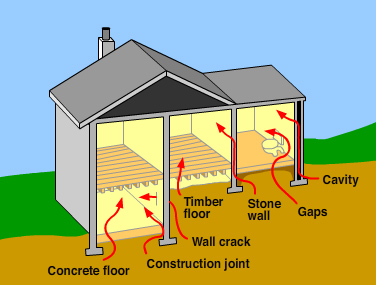How to reduce radon levels
Radon address search
A report will tell you the estimated probability above the Action Level.
Order a reportRadon measurement pack
Find out the yearly average radon level for a property and if it is above or below the Action Level.
Order a domestic pack Order a workplace packEverything you need to know about radon
Radon is a colourless, odourless radioactive gas formed by the radioactive decay of the small amounts of uranium that occur naturally in all rocks and soils.

The ground is the main source of radon.
The aim of remedial work is to reduce radon levels as low as possible. There are several methods that can be used to reduce high radon levels. Have you already tested? Use our interactive tool to help you decide whether you need to reduce your radon level and if so how.
Remedial methods
Some simple actions such as sealing around loft-hatches, sealing large openings in floors and extra ventilation do not reduce radon levels on their own. When combined with other effective measures, they can improve the reduction of radon levels. Completely sealing floors is difficult and can cause rot in wooden floors. The diagram below is intended as a guide. The Environmental Health Department of your local council may be able to offer advice. For levels in excess of 1000 Bq m-3 you may wish to contact UKHSA for advice.
| Floor type | Solid |
Suspended |
||
| Radon level* (Bq m-3) |
Under 500 |
Over 500 |
Under 500 |
Over 500 |
| Recommended solutions, best first | Radon sump or Positive ventilation |
Radon sump | Natural under-floor ventilation or Positive ventilation |
Mechanical under-floor ventialtion or Natural under-floor ventilation |
For houses with mixed floor types, a combination of the above can be used.
*The level of 500 Bq m-3 is an approximate guide.
|
An active radon sump, fitted with a fan, is the most effective way to reduce indoor radon levels. Sumps work best under solid floors and under suspended floors if the ground is covered with concrete or a membrane. Occasionally, passive sumps without a fan may reduce radon levels.
|
Read more |
|
A small quiet fan blows fresh air, usually from the roof space, into the building.
|
Read more |
|
Many homes and some workplaces have a suspended ground floor with a space underneath. Good ventilation of this space can reduce radon concentrations.
|
Read more |
|
A fan is used to either continuously blow air into or extract air out from the space below a suspended floor. This can be used when natural under-floor ventilation is inadequate to reduce radon level.
|
Read more |
|
Guidance on how to reduce radon levels in cellars and basements.
|
Read more |
Remedial costs
Costs depend on many factors including the complexity of the building and whether any of the work can be done by DIY. The table below shows approximate costs for measures installed by a contractor (apart from the DIY sump).
| Remedy | Typical cost | Normal range |
|---|---|---|
| Active sump (with fan) | £800 | Up to £2,000 |
| Active sump (DIY) | £300 | Up to £700 |
| Passive sump (without fan) | £450 | Up to £1,000 |
| Natural under-floor ventilation | £200 | Up to £600 |
| Active under-floor ventilation | £700 | Up to £1,500 |
| Positive ventilation | £550 | Up to £1,000 |
Average prices above derived from data between 2007 - 2017.